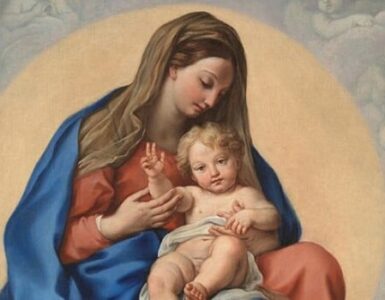St. John the Lateran Basilica in Rome is the oldest of the four great “patriarchal” basilicas of Rome. In ancient times, the land where it stands was occupied by the palace of the family of the Laterani. In the time of Nero, a member of the family, Plautius Lateranus, was accused of conspiracy against the emperor, and his goods were confiscated. The palace came eventually into the hands of Constantine, the first Christian emperor, through his wife Fausta, and it is from her that it derived the name by which it was then sometimes called, “Domus Faustæ.” Constantine must have given it to the Church no later than about 311, for we find a council against the Donatists meeting within its walls as early as 313. From that time on it was always the center of Christian life within the city; the residence of the popes and the cathedral of Rome.
It seems probable, in spite of the tradition that Constantine helped in the work of building with his own hands, that there was not a new basilica erected at the Lateran, but that the work carried out at this period was limited to the adaptation, which perhaps involved the enlargement of the already existing basilica or great hall of the palace. This original church was probably not of very large dimensions, but we have no reliable information on the subject. It was dedicated to the Savior, “Basilica Salvatoris”; the dedication to St. John being of later date, and due to a Benedictine monastery of St. John the Baptist and St. John the Evangelist which adjoined the basilica and whose members were charged at one period with the duty of maintaining the services in the church. Its splendor at an early period was such that it became known as the “Basilica Aurea,” or Golden Church. This splendor drew upon it the attack of the Vandals, who stripped it of all its treasures.
St. Leo the Great restored the church around 460, and it was restored again by Hadrian I, but in 896 it was almost totally destroyed by an earthquake. The damage was so extensive that it was difficult to trace in every case the lines of the old building, but these were for the most part respected and the new building was of the same dimensions as the old. This second church lasted for four hundred years and was then burnt down. It was rebuilt by Clement V and John XXII, only to be burnt down once more in 1360, but again rebuilt by Urban V.
It was not until the latter part of the seventeenth century that the church took its present appearance, in the restoration carried out by Innocent X, with Borromini for his architect. The church lost its appearance of an ancient basilica and was completely altered in character.
The ancient apse, with mosaics of the fourth century, survived all the many changes and dangers of the Middle Ages, and was still to be seen very much in its original condition as late as 1878, when it was destroyed in order to provide a larger space for the ordinations and other pontifical functions which take place in this cathedral church of Rome. The original mosaics were, however, preserved with the greatest possible care and very great success, and were re-erected at the end of the new and deeper apse which had been provided. In these mosaics, as they now appear, the center of the upper portion is occupied by the figure of Christ surrounded by nine angels. This figure is extremely ancient and dates from the fifth, or maybe even the fourth century. It may be regarded as going back to Constantine and the first days of the basilica. The remaining mosaics of the apse are of the thirteenth century, and the signatures of the artists, Torriti and Camerino, may still be read upon them. Camerino was a Franciscan friar; perhaps Torriti was one also.
The high altar, which formerly occupied the position customary in all ancient basilicas, in the center of the chord of the apse, has now beyond it, owing to the successive enlargements of the church, the whole of the transverse nave and of the new choir. It has no saint buried beneath it, since it was not, as were almost all the other great churches of Rome, erected over the tomb of a martyr. It stands alone among all the altars of the Catholic world in being of wood and not of stone, and enclosing no relics of any kind. The reason for this peculiarity is that it is itself a relic of a most interesting kind, being the actual wooden altar upon which St. Peter is believed to have celebrated Mass during his residence in Rome. It was carefully preserved through all the years of persecution, and was brought by Constantine and Sylvester from St. Pudentiana’s, where it had been kept till then, to become the principal altar of the cathedral church of Rome. It is now, of course, enclosed in a larger altar of stone and cased with marble, but the original wood can still be seen. A small portion was left at St. Pudentiana’s in memory of its long connection with that church, and is still preserved there.
Lessons
Unfortunately, we live in an age where many feel that old things and old ways are to be done away with. How wonderful that our ancestors were so wise as to preserve the beautiful and sacred buildings of the past. We need to take lessons from our ancestors and instead of tearing down, restoring — not only our churches, but our traditions and our Catholic faith, which is truly a gift from God.
From Johnnette Benkovic’s Graceful Living: Meditations to Help You Grow Closer to God Day by Day
When Christ came, He banished the devil from our hearts, in order to build in them a temple for Himself. Let us therefore do what we can with His help, so that our evil deeds will not deface the temple.
— From a homily of St. Caesarius of Arles
Johnnette’s Meditation
What stone of virtue can I use today to help build a temple for Christ within myself? What one defaced stone can I work to remove?
Prayer
Thank you, Father, for the preservation of this ancient and sacred basilica. May we learn from this dedication day the importance of preserving not only sacred buildings but our holy traditions. We thank you, Lord, for Your many blessings. Help us not to take them for granted, but to always treasure and venerate Your holy gifts. Amen.
Other Saints We Remember Today
St. Theodore the Recruit (306), Martyr
image: Pompeo Molins (1827-1893)., Public domain, via Wikimedia Commons














